
Seismic
section displaying chaotic deformation in the inner core of the Mount
Ashmore structural dome.
A massive asteroid hit the
Timor Sea around 35 million years ago - and the impact apparently
contributed to the formation of the Antarctic ice sheets.
So says Andrew Glikson, a specialist in the study of extraterrestrial
impacts, from the Planetary Science Institute at the Australian National
University in Canberra, who analysed a dome found 2.5 kilometres below
the Timor Sea, about 300 kilometres off Australia's north west coast.
Based on the structure of the dome, called Mount Ashmore, there were two
obvious explanations for its formation: from a mud volcano or from the
movement of tectonic plates.
But using a barrage of tests including scanning electron microscopy and
seismic surveys, as well as chemical analysis of the rocks, Glikson
concluded that the dome was the result of an asteroid crashing into the
Earth at such speeds that it caused the Earth's crust to rebound (Australian
Journal of Earth Sciences, DOI: 10.1080/08120099.2010.481327).
Images from scanning electron microscopy showed that the cracks and
pulverised rocks throughout the dome were unlike those seen in tectonic
plate movements.
Seismic surveys and above-ground magnetic studies revealed the
dome's massive dimensions. Its diameter of over 50 kilometres and
vertical axis several kilometres in height are significantly larger than
previously found mud volcanoes - making this an unlikely candidate for
one. So far the largest mud volcanoes, found in Azerbaijan, are only
10km in diameter.
According to ABC News, Glikson
says the asteroid that created the dome was probably 5 to 10km wide.
Discovery News reports that:
"Smaller [asteroid] impacts only create an impact crater. But during
larger impacts, something different may happen: an impact dome or
central peak rises up in the middle of the crater."
In the case of Mount Ashmore, rock rebounded upwards at the point of
impact, compensating for the huge compressive punch of energy delivered
in collision. And when this asteroid collided with Earth, it wasn't
alone.
Australian Geographic reports:
"Several other craters have been documented from a similar time,
including one of the Western Australian coast measuring 120km in
diameter. Another asteroid impact structure in Siberia is 100km in
size."
Glikson believes that this asteroid storm may have shifted the Earth's
plates to create a gap between Antarctica and South America, known as
the Drake Passage, which still exists today.
Discovery News writes:
"The rush of water through Drake Passage isolated Antarctica's climate
from the rest of the globe, and fostered the growth of a large ice
sheet."
According to Australian Geographic, these ice sheets in
combination with newly-emerging currents around Antarctica may have
allowed cooler water into the world's ocean, and possibly resulted in a
well-documented cooling of the planet.
Scottsboro,
Alabama - On May 18th, NASA cameras at the Marshall Space Flight Center
and Walker County Science Center near Chickamauga, Georgia tracked the
entry of a large meteor estimated to weigh some 60 pounds over
northeastern Alabama.
This meteor was first picked up at an altitude of 47 miles over
northwest Huntsville, moving at a speed of 8 miles per second towards
the southeast. It was last visible northeast of Gurley at an altitude of
23 miles.
The meteor was quite bright, with an intensity rivaling that of the
waxing crescent Moon (in astronomical terms, it was about visual
magnitude -8.3). Calculations automatically performed by the tracking
software indicates that this interloper was from the main asteroid belt,
moving in an orbit which takes it more than three times Earth's
distance from the Sun.
Expert opinion is that one or more pieces of this meteor
survived to make it to the ground as meteorites, and calculations
indicate that the area of the fall lies north of a line joining
Woodville and Scottsboro.
Residents who saw the meteor on the night of the 18th, or those who have
may noticed or picked up an unusual rock in the vicinity are requested
to contact the NASA Meteoroid Environment Office at the Marshall Space
Flight Center.
Eyewitnesses are asked to give a detailed description, including the
time of the sighting, and those who suspect they have a meteorite are
requested to give the location of the find and provide a digital photo
of the object.
If you think you may have seen the meteor, call Dr. Bill Cooke at
256-544-9136 or email him at william.j.cooke@nasa.gov.
Watch Video
A
seemingly normal rock found in a ditch along a stretch of road in north
central Oregon has turned out to be a stone from outer space that
travelled across millions of miles and billions of years to reach Earth,
according to researchers studying the stone.
The 40-pound, cone-shaped space rock, which is about the size of a beach
ball, was picked up by Donald Wesson and his wife Debbie during the
fall of 1999 as they drove through Oregon's wheat country on their way
home to Washington. It is the fifth meteorite to be found in the
northwestern state.
The space rock, which sat anonymously on the planet's
surface for a few hundred to a thousand years, remained unidentified for
another decade as it rested in Wesson's garden.
Only after spending time beneath a deck barbeque, visiting a county fair
and passing through two universities did it receive the official
classification as a meteorite. [Meteorite craters on Earth.]
"It was probably plowed up by a farmer and tossed to the side of the
road," said Dick Pugh, a geologist at Portland State University in
Oregon. "There is even evidence that the rock was hit by a plow."
Space rock's tall tale
Wesson finally began asking around after watching a television program
about meteorites. He took the rock to a local county fair
in Castle Rock, Washington in the summer of 2009, where he spoke with a
member of the Southern Washington Mineralogical Society.
The find was referred to Western Washington University in Bellingham,
Wash., where initial sample tests showed it was probably a meteorite.
Final confirmation came from the Cascadia Meteorite Laboratory at
Portland State University, which classified the Morrow County meteorite
as an L6 ordinary chondrite that had been highly shocked (S5) but
minimally weathered (W1).
The latest find represents a relatively common type of meteorite,
according to Melinda Hutson, a planetary scientist at Portland State
University who helped make the classification. But, she added that it
has several intriguing features.
"The meteorite isn't significantly weathered, but it has a distinctive
yellow tint caused by weathering unlike that seen in meteorites
recovered from deserts in Africa or Antarctica," Hutson said. "Also, it
has beautiful shock veins and glass, caused by a major collision in
space."
Based on its type, the Morrow County meteorite was likely formed
approximately 4.5 billion years ago, said Alex Ruzicka, a planetary
scientist at Portland State University.
"Given the kind of meteorite that it is, and the shock effects that it
experienced, it probably started its travels to Earth from the asteroid
belt about half a billion years ago," Ruzicka told SPACE.com.
Morrow County meteorite
Both the name and classification of the meteorite have received official
approval from the Nomenclature Committee of the Meteoritical Society,
and a type sample now resides with Portland State University.
Meteorites can easily remain anonymous in Oregon's heavily forested
lands west of the Cascades, and many dark-colored volcanic rocks to the
east of the Cascades look similar to real, dark-colored meteorites.
Dark bedrock geology and high levels of precipitation translate into 34
times fewer meteorites recovered in Oregon per square mile than in
Kansas, a state with light-colored bedrock and very little forest. But
that has not dimmed the confidence of Oregon's meteorite hunters.
Previously, only four meteorites have been recovered from Oregon,
including Sam's Valley, found in 1894; Willamette, found in 1902;
Klamath Falls, found in 1952; and Salem, which fell in 1981. Three of
these are iron meteorites, whereas Salem and the newly classified Morrow
County are both stony meteorites.
The Morrow County meteorite is substantially bigger than the Salem
fragment, which is only a few centimeters across, said Ruzicka. The
Salem meteorite was found by a policeman, after it hit the roof of his
car in the late evening while he was off duty.
"In a way, I'm not surprised at all by this discovery," Ruzicka said.
"With our vigorous outreach effort I always knew the lab would help to
recover more meteorites from Oregon, I just didn't know when. Maybe this
will be the start of many more to come"
Asher Moses
Sydney Morning Herald
Tue, 21 Jul 2009 10:49 EDT
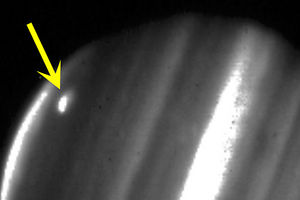
Confirmed by NASA: A large impact on the left on
Jupiter's south polar region captured on July 20, 2009, by NASA's
Infrared Telescope Facility in Mauna Kea, Hawaii. Jupiter was slammed by
an object leaving an Earth-sized impact, exactly 15 years after Comet
Schumacher-Levy did the same in 1994.
An amateur
Australian astronomer has set the space-watching world on fire after
discovering that a rare comet or asteroid had crashed into Jupiter,
leaving an impact the size of Earth.
Anthony Wesley, 44, a computer programmer from Murrumbateman, a village
north of Canberra, made
the discovery about 1am yesterday using his backyard 14.5-inch
reflecting telescope.
The impact would have occurred no more than two days earlier and will
only be visible for another few days.
Within hours, his images had spread across the internet on science
websites.
NASA's Jet Propulsion Laboratory confirmed the discovery at 9pm yesterday using its
large infrared telescope at the summit of Mauna Kea in Hawaii.
The only other time astronomers have discovered
evidence of a space object having hit Jupiter was when the
Shoemaker-Levy 9 comet collided with the giant planet in July, 1994.
That event was also the first direct observation of two objects
colliding in space.
Glenn Orton, the NASA scientist who confirmed Wesley's discovery, said:
"We are extremely lucky to be seeing Jupiter at exactly the right time,
the right hour, the right side of Jupiter to witness the event. We
couldn't have planned it better."
Orton said he was not yet sure whether the object that hit Jupiter was a
comet, asteroid or some other piece of space junk. But the impact mark is about the size of the Earth.
"It's been a whirlwind of a day and this, on the
anniversary of the Shoemaker-Levy 9 and Apollo anniversaries, is
amazing," he said.
To most people the image is unremarkable and appears as little more than
a scar on Jupiter's vast gas surface.
Leigh Fletcher, an astronomer who worked with Orton on confirming the
discovery last night, said: "These are the most exciting observations
I've seen in my five years of observing the outer planets."
Wesley said in a phone interview that documenting these sorts of impacts
was the only way to get new data on how the solar system formed and
what planets such as Jupiter are made of, as the impact throws up debris
that would otherwise be invisible when looking through a telescope from
Earth.
The collision also allows astronomers to examine Jupiter's role in
cleaning up space debris in the solar system.
"If anything like that had hit the Earth it would have been
curtains for us, so we can feel very happy that Jupiter is
doing its vacuum-cleaner job and hoovering up all these large pieces
before they come for us," he said.
"An impact event like this, even just knowing how often they happen,
gives you some idea of how much debris is left over from the solar
system when it formed and how quickly Jupiter is vacuuming up the
remains of the bits and pieces floating around in the solar system."
Mike Salway, who runs the Australian amateur astronomy community website
iceinspace.com.au, said astronomers around the world were raving about
the discovery.
"Amateur astronomers are all over it at the moment - they all had their
telescopes out last night looking for it," he said.
Wesley, who has been keen on astronomy since he was a child, said
telescopes and other astronomy equipment were so inexpensive now that
the hobby had become a viable pastime for just about anybody. His own
equipment cost about $10,000.
In many cases, particularly with planets such as Jupiter, professional
space watchers were turning to amateurs to provide them with new
discoveries.
"A lot of the professional astronomers have access to large scopes but
those scopes are in demand for all sorts of other jobs and you just
can't afford to tie up a large telescope worth millions of dollars
looking at Jupiter every night," Wesley said.
"These large telescopes only get built because of the interests of the
consortium parties, and those interests need to be attended to, so it's
really left to amateurs who've got no fixed agenda to image whatever
they find interesting."
Sean Walker
Sky & Telescope
Thu, 03 Jun 2010 20:54 EDT
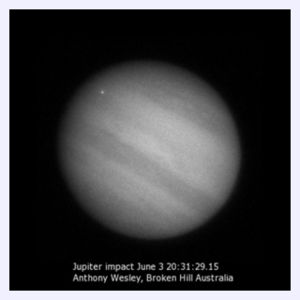
Another impact? This single frame from a short video
shows Jupiter sporting a bright "fireball" at upper left.
Not
just one but two veteran planetary imagers caught the shots of a
lifetime on June 3rd, when they both video recorded a tiny, brilliant
flare on Jupiter swelling and fading around 20:31 Universal Time. The
flare brightened and faded in less than two seconds. Its progress is
recorded on many frames of each video.
The flare may have looked small from Earth, but it must have been
titanic to be seen at all from Jupiter's distance - and on Jupiter's
daylit side. It was presumably the impact of an asteroid or comet
nucleus.
Veteran planetary imager Anthony Wesley, an amateur in Murrumbateman,
Australia, was recording in red light at the lucky moment in order to
create another of his many stacked-video color stills of Jupiter. The
impact "doesn't seem to have left any mark, so it probably burned up in
the upper atmosphere before it reached the cloud deck," suggests Wesley.
At the same moment, Christopher Go was imaging Jupiter several thousand
miles away in the Phillipines. He was taking blue frames at the moment
of impact. Go's video of the Jupiter impact provides ironclad
confirmation of the event!
The flare occurred at longitude 248.8° in Jupiter's System I, 342.7° in
System II, and 159.4° in System III. The latitude is 16° south. This
region should be visible from about 4:00 to 6:30 June 4th UT, favoring
observers in Europe and Africa when Jupiter is up before dawn. The
impact site will return to good view about every 9 hours 56 minutes
thereafter.
Wesley is well known for discovering an impact on Jupiter last July 19 -
by the dark mark it left behind - spurring telescopes around the
world (and above it) to study the serendipitous event.
Stay tuned for updates!
From Space
Weather we find this article:
Amateur astronomers Anthony Wesley of Australia and Christopher Go of
the Philippines have independently observed an impact event on Jupiter.
The strike occurred at 20:31 UT on June 3rd and produced a bright flash
of light in the giant planet's cloudtops:
"I still can't believe
that I caught a live impact on Jupiter," says Go, who has made a must-see video of the event.
"There were no visible remains at the impact point for the next half
hour or so, until sunrise put an end to the imaging," says Wesley.
The nature of the impactor is presently unknown. It might have been an
asteroid or a comet. In either case, a dark and cindery debris field is
expected to develop around the impact point; that's what has happened in
the aftermath of previous Jupiter impacts. Professional and amateur
astronomers are encouraged to monitor Jupiter in the hours ahead, and
stay tuned for updates.
Update: Anthony Wesley has pinpointed the
impact site at Jovian latitude minus 16.1o, and central meridian
longitudes CM1: 300o, CM2: 33.8o and CM3: 210.4o.
Mary Poletti
Quincy Herald-Whig
Fri, 04 Jun 2010 15:08 EDT
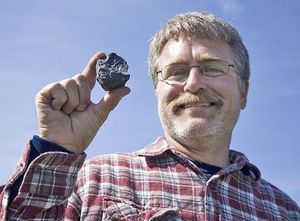
Meteorite hunter Karl Aston of St. Louis, whose in-laws live in Quincy,
holds up the meteorite chunk he found in southwest Wisconsin in April,
shortly after a meteorite was sighted in the Upper Midwest. The chunk
weighs in at 160 grams, the largest piece of the space rock found so
far.
When Karl Aston saw a fireball in the sky, his first thought was of chasing it.
The St. Louis research chemist, whose in-laws live in Quincy, hunts for
and collects meteorites in his spare time. After a meteorite streaked
across the night sky on April 14 as a brilliant fireball visible to the
naked eye across the Upper Midwest, Aston traveled to its landing place
in rural southwest Wisconsin and found one of the largest discovered
chunks of the rock.
Scientists are thrilled by discoveries like Aston's, pointing
to the modern rarity of visible meteorites and the clues about space
and Earth their remnants provide.
"This is really top-notch science," said Gregg Maryniak,
director of the St. Louis Science Center's James S. McDonnell
Planetarium, which will display Aston's meteorite chunk later this
summer.
Aston took up meteorite hunting and collecting three years
ago. He has since networked with many other meteorite hunters around
the country, developing "a lot of camaraderie and friendly competition"
with them.
In the days after the April meteorite sighting, an
estimated 20 to 30 hunters gathered in Wisconsin, hoping to pinpoint
the meteorite's landing place and hunt for chunks of the rock.
After four days of tracking the rock's path through radar,
talking with landowners and walking through rural fields for an
estimated 100 hours, Aston came across the first of five meteorite
chunks the group would ultimately find.
"I just saw it sitting on top of a grass pasture, 20 feet away," Aston said. "From 10 feet away, I knew it was a meteorite."
Aston's meteorite chunk weighs about 160 grams, heavy with
minerals such as iron that sparkle in the sunlight under the rock's
burnt-black exterior. He said the largest chunk that has been found
weighs about 300 grams, although softball- and basketball-sized chunks
of the car-sized rock still might be out there.
"Most of the meteorites will never be found," Aston said,
estimating that hundreds or even thousands of meteorite chunks fell to
Earth, though fewer than 100 have been found. Most already have been
plowed over by the landowners, he said.
Aston's interest in meteorites is "more than a hobby, I would
submit to you," said the St. Louis Science Center's Maryniak.
"Understanding these cosmic collisions and impacts is extremely
important."
Maryniak pointed to meteorites as the cause of the moon's formation and the ancient source of much of Earth's water.
"People who pursue these finds are really doing the community a
service" by using them to educate the public about science, he said.
Aston continues that service in his spare time, inspecting
rocks found by landowners who want to have identified as either
meteorites or, as Aston jokes, "meteor-wrongs." He frequently works
with the planetary sciences department at Washington University in St.
Louis.
The St. Louis Science Center will display Aston's meteorite
chunk in its planetarium throughout July and August before it moves to
a permanent home at a museum in Wisconsin.
Peter Davenport
National UFO Reporting Center {NUFORC)
Sat, 05 Jun 2010 11:47 EDT
Occurre : 5/4/2010 21:25 (Entered as : 05/04/10 21:25)
Reported: 5/5/2010 12:47:23 AM 00:47
Posted: 5/12/2010
Location: Ewa Beach, Hawaii
Shape: Light
Duration: 2 seconds
Two bright flashes lighting up the entire sky and a single light streaking down.
I was sitting on my back porch with my girlfriend drinking coffee and
talking, when two bright flashes lit up the sky, almost like lightning.
I was expecting to hear thunder, and at the same time my mind was
trying to figure out how there could be lightning when there was no
sign of rain, when I saw a small white light move from behind the
clouds in the southeastern sky and move at a high rate of speed down
out of view.
The flashes pulsed quickly one after the other and the
light was visible for only another second after that. I grabbed my
laptop and started to do internet searches to see if perhaps anyone
else had seen it when I found this website.
To clarify, my house is almost directly underneath the landing
path for airplanes landing at Honolulu International Airport, and there
were absolutely no aircraft of any kind in the sky for at least an hour
before this incident, nor have there been any aircraft in the time it
has taken me to get my laptop and make this post.
Kaali,
on the Estonian island of Saaremaa, is the site of the last giant
meteorite impact to occur in a densely populated region. The landscape
that the collision left in its aftermath has been the subject of many
mythological tales and may have been home to a mysterious ancient cult.
About 7,500 years ago, a huge rock from space came hurtling
toward the earth, faster than a speeding rocket. Several kilometers
above the earth's surface, the meteorite broke into pieces from the
pressure and heat of the atmosphere. The resulting chunks collided into
Saaremaa with the force of a small nuclear bomb, wreaking havoc on the
landscape and possibly claiming numerous victims.
The explosion left nine total craters, now known as the Kaali
Meteorite Crater Field. Some of these craters are quite small: one
measures only twelve meters across and one meter deep. But the most
interesting of the group is the largest crater, a gently sloping bowl
filled with stagnant, murky water.
Simply known as Kaali crater, the largest crater (which
measures 110 meters across) is believed to have been a sacred site for
many centuries, in part due to its cosmic origin. Surrounding Kaali
crater are the remains of an immense stone wall from the Late Bronze
Age, stronger than any similar structures in the region and providing
clues to the crater's use by ancient peoples.
Archaeologists
believe it is possible that the wall served as a stronghold for an
ancient cult settlement. As evidenced by the unusually large quantity
of animal bones found within the wall's borders, the Kaali crater lake
was not only a watering place but also a place of sacrifice. While it
is known that Estonians have made live offerings in the past (for good
harvests and other reasons), one curious aspect of the site's animal
remains is that some date back only to the 1600s, long after the Church
forbade such rituals.
Some even believe that ancient offerings still remain
undiscovered at the bottom of the six-meter-deep Kaali lake. However,
deposits of oak trees in the water have prevented scientists from
probing beyond four meters below the surface. Whatever the case may be,
Kaali is a site of indisputable importance, historically and
scientifically speaking.
The experience doesn't end at the crater field. There is even
a Kaali Meteor Museum and Hotel - in case you want to stay for another
day among ancient cult ruins and the evidence of terrifying
destruction.
A fresh comet is swinging through the inner solar system, and it is
brightening rapidly as it approaches the sun. Presenting, Comet
McNaught (C/2009 R1):
Michael
Jäger of Stixendorf, Austria, took the picture on June 6th using an
8-inch telescope. The comet's green atmosphere is larger than the
planet Jupiter, while the long willowy ion tail stretches more than a
million kilometers through space. These dimensions make the comet a
fine target for backyard telescopes.
Comet McNaught can be found low in the northeastern sky before
dawn gliding through the constellation Perseus. It is brightening as it
approaches Earth for a 1.13 AU close encounter on June 15th and 16th.
Currently, the comet is at the threshold of naked eye visibility (5th
to 6th magnitude) and could become as bright as the stars of the Big
Dipper (2nd magnitude) before the end of the month. Estimates are
uncertain, however, because this comet is a newcomer to the inner solar
system, and thus somewhat unpredictable.
Readers are encouraged to wake up before dawn and monitor developments. [sky map] [ephemeris] [3D orbit] [full story].
More images: from Primoz Cigler of Bohor, Slovenia; from Pete Lawrence of Selsey, West Sussex, UK; ; from Monika Landy-Gyebnar of Veszprem, Hungary; from Petr Horalek of Ustupky, Czech republic
Periodico26.cu
Sat, 12 Jun 2010 22:38 EDT
Orfilio Pelaez
People said that on Monday night they saw a striking luminous
phenomenon in the sky in parts of the Pinar del Río municipality of
Consolacion del Sur.
One of the witnesses of this peculiar event, Dr. Efren Jose
Jaimez Salgado, a researcher at the Institute of Geophysics and
Astronomy (IGA) of the Ministry of Science Technology and Environment,
said that while visiting the home of relatives he could see a huge
bright fireball, which rapidly crossed the sky north to south of Pueblo
Nuevo, located on the outskirts of the town of Consolacion.
The incident occurred around 22:40 pm when a meteoric object,
apparently quite large, entered the atmosphere and crossed the night
sky from side to side, leaving behind a huge bright greenish white
trail.
According to the specialist, the fireball went out of
sight very fast, penetrating to the south of that town. A few seconds
later an explosion was heard.
According to Dr. Ephrem, the supposed cosmic body could have
fallen at some point south of the town of Alonso de Rojas, or in the
sea in the Gulf of Batabano.
Although numerous people witnessed the exciting spectacle it
cannot be confirmed that this was a meteorite until its remains are
located and subjected to studies to verify their composition and
origin.
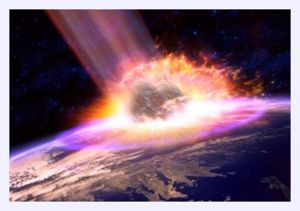
Crash
landing: every 100 million years, a rock the size of a small asteroid
slams into the Earth, causing earthquakes, tidal waves, and killing all
large land animals.
Apocalyptic thought has a
tradition that dates to the Persian prophet Zoroaster in the 14th
century BC. Recently, anxiety has grown over the prediction of the end
of the world in the Mayan calendar.
It's true that the Mayan odometer will hit zeros on 21
December 2012, as it reaches the end of a 394-year cycle called a
baktun. But this baktun is part of a larger 8,000-year cycle called a
pictun, and there's no evidence that anything astronomically untoward
will happen as the current baktun slides into the next. However, that
hasn't stopped the feverish speculating that sells books and cinema
tickets.
What kind of catastrophe would it take to end the world?
Astronomical intruders provide a potentially serious threat. Impacts
can be caused by stray rubble from the Asteroid Belt and the rocky
snowballs that travel in highly elliptical orbits in the comet cloud.
There are many fewer large bits of debris than small bits, so the
interval between large impacts is much longer than the interval between
small impacts.
That's good news. Every century or so, a 10-meter
meteor slams into the Earth with the force of a small nuclear device.
Tunguska was the site of the last, in 1908, and it was pure luck that
that meteor landed in the uninhabited wilderness of Siberia. Every few
thousand years, Earth can pass through unusually thick parts of the
debris trail of comets, turning the familiar light show of a meteor
shower into a deadly firestorm. Roughly every 100,000 years, a
projectile hundreds of meters across unleashes power equal to the
world's nuclear arsenals. The result is devastation over an area the
size of England, global tidal waves (if the impact is in the ocean),
and enough dust flung into the atmosphere to dim the Sun and kill off
vegetation. That could ruin your day.
Then there's the "Big One". About every 100 million years, a
rock the size of a small asteroid slams into the Earth, causing global
earthquakes, kilometre-high tidal waves, and immediately killing all
large land animals. Creatures in the sea soon follow, as trillions of
tons of vaporised rock cause drastic cooling and the destruction of the
food chain based on photosynthesis. There's good evidence that this
happened 65 million years ago and our tiny mammal ancestors were the
beneficiaries as the giant lizards were extinguished.
A hundred million years sounds like a safe buffer, but the
next one could happen at any time. But you can take it off your worry
list - astronomers have it covered. A network of ground-based
telescopes scans the skies for bits of rogue rubble larger than a few
hundred meters. That's ample time to dust off the nuclear arsenals for
an interception mission if we had to. Unfortunately, the Dr Strangelove
approach creates lethal shrapnel travelling in the same direction as
the original object; a smarter strategy is to send a spacecraft
alongside it and gently "tug" it with gravity onto a slightly different
trajectory.
When massive stars exhaust their nuclear fuel, the result is a
titanic explosion called a supernova. The dying star brightens to rival
an entire galaxy and emits high-energy particles that can destroy the
ozone layer of a planet like Earth if it occurs within 30 light years.
The demise of large North American mammals 41,000 years ago has been
linked to a supernova, and several other mini-extinctions may be tied
to the cataclysm of stellar death.
A supernova is a small squib compared to a hypernova. In this dramatic
and rare event, the violent collapse of a very massive star ejects jets
of gas and high-energy particles at close to the speed of light, and
for a few moments the star outshines the entire universe in gamma rays.
If a hypernova went off within 1,000 light years, and Earth
was within the narrow cone of high- energy radiation, we'd experience
an immediate global conflagration. It's brutal luck if a hyper nova
ever goes off with its beam aimed at us.
On longer time scales, attention turns to the sheltering Sun.
Our constant companion is midway through its conversion of hydrogen
into helium. In about 5 billion years, its guttering flame will be
extinguished. The Sun's diffuse envelope will engulf the Earth and turn
it into a lifeless cinder. This is death by stellar cremation.
If that seems like a comfortably distant prospect, the
biosphere will actually die much sooner. The Sun burns hot as it gets
older, and in 500 million years a turbocharged version of global
warming will turn the Earth into a global desert.
That gives us plenty of time to find better real estate. Titan
looks promising. It already has the nitrogen - just add oxygen and
presto! Our second home. And those wild-eyed rocket scientists who want
to save us from asteroids have a thrilling plan up their sleeves:
deliberately bring an asteroid in close, and with each pass it will
transfer a little energy to the Earth and nudge it further from the
Sun. After a few million close calls we'll have migrated to a more
hospitable orbit.
Stars come and go but galaxies seem eternal. A galaxy like the Milky
Way acts like it has all the time in the world. Its spiral arms are
cauldrons where new stars form out of gas that falls in like a fine
rain from intergalactic space. Stars like the Sun will some day die,
but in Orion and Taurus freshly minted stars are switching on for the
first time. The bright fizz of supernovae is a sideshow; most stars die
modestly and leave behind fading embers. Stellar lifetime is a strong
function of mass because low mass stars are misers with their hydrogen.
The lowest mass stars will eke out a dim existence for over a trillion
years.
The end of the Milky Way will come slowly, in a stellar
lockdown. Massive stars live short lives and die explosively as
supernovae - leaving behind a neutron star or a black hole, neither of
which emits any light. Stars like the Sun and those less massive will
die as white dwarfs - that is, as slowly cooling, carbon-rich embers.
Gradually the cycle of star birth and death will be irrevocably broken.
More and more mass will be trapped in compact stellar remnants or
cooling white dwarfs. In galaxies across the universe the lights will
gradually go out, and after tens of trillions of years the universe
will have faded to black. But as bleak as it sounds, the end of
starlight doesn't mean life must end.
A star shines by converting a tiny proportion of the energy
locked in pure matter into radiation. The ultimate source of starlight
is gravitational energy. There are many ways other than fusion to turn
gravitational energy into heat or radiation, so even after the stars
have all faded enterprising civilisations could live by harnessing the
energy of black holes. New artificial stars could be created if
nostalgia dictated.
Fifteen years ago, it was discovered that the cosmic expansion is
getting faster. The cause is inferred to be dark energy - a
manifestation of the pure vacuum of space that has an effect opposite
to gravity: it repels rather than attracts. Its existence was indicated
by the fact that distant supernovae are fainter than expected in a
decelerating universe. Dark energy is an embarrassment: fundamental
theories don't predict it, and no one knows how a pure vacuum can have
such a bizarre property.
In some theories, dark energy is not the cosmological
"constant" of Einstein's original formulation, but varies over time and
space. If dark energy grows, it will cause the universe to unravel in
about 20 billion years in a crescendo called the "Big Rip". First
galaxies, then stars, and finally atoms will be torn asunder by dark
energy. Nothing can survive; it's an outcome of crushing finality.
Absent the big rip, cosmic acceleration will steadily remove
galaxies from view. After 100 billion years, most galaxies will recede
faster than the speed of light, leaving frozen final images on the edge
of our horizon as if at the boundary of a black hole. The Milky Way and
Andromeda galaxies will merge and our view of the universe will end at
the edge of this super-galaxy. On even longer time scales, familiar
gravitational structures become unglued. In about 1015 years, planets detach from their dead stars and drift through interstellar space. In about 1019,
years stars detach from galaxies and float off into intergalactic
space. In most theories that unify fundamental particles in terms of a
single super-force, the proton is not stable and will decay in
something like 1035 years. This vast time scale is to the age of the universe what the age of the universe is to a millisecond.
The decay of protons heralds a final drawn-out phase of disintegration
in the universe, as everything falls apart. After protons decay, there
are no stable atoms, presenting a challenge for life. The curtain falls
with the slow evaporation of black holes by a process called Hawking
radiation. The largest black holes evaporate on the inconceivable time
scale of 1098
years. We imagine the last inhabitants of the universe huddled around
the evaporative glow of gamma rays from the last black hole, telling
timeless stories about time. It was fun while it lasted.
One wonders... Did the inhabitants of galaxy NGC 891 duck when Comet
McNaught flew past the edge-on spiral on the morning of June 8th? Mike
O'Connor and Tristan Dilapo took this picture of the cosmic close
encounter from Colden, New York:
"The
comet was only 10 degrees above the horizon," says O'Connor.
"Nevertheless, we got a good picture using a 12-inch telescope and an
SBIG ST9-E camera."
And, no, the denizens of that distant galaxy did not flinch,
flee, duck or take notice in any way. NGC 891 is 30 million light years
away, far removed from the willowy tail of Comet McNaught.
We Earthlings are having the true close encounter. Comet
McNaught (C/2009 R1) is gliding through the inner solar system, due to
approach our planet only 100 million miles away on June 15th and 16th.
The approaching comet looks great in small telescopes, and may yet
become a naked-eye object before the end of the month. Because this is
Comet McNaught's first visit, predictions of future brightness are
necessarily uncertain; amateur astronomers should be alert for the
unexpected.
Get the full story and a finder chart from Sky & Telescope. See also: ephemeris, 3D orbit.
More images: from Kerry-Ann Lecky Hepburn of Grimsby, Ontario; from Gregg Ruppel of Ellisville, MO; from Michael Jäger of Turmkogel, Austria; from Scott Tucker of Tucson, Arizona; from Jeff Greenwald of Laramie, Wyoming; from Feys Filip at the Public observatory "Sasteria" in Crete; from Gary of Fort Davis, TX; from Baqir of Quetta, Pakistan
Most of Oort Cloud 'of extra-solar origin', say boffins
Halley's comet and other famous objects in our solar system may in fact
have formed in orbit around alien suns far off across the vast gulfs of
interstellar space, according to new research.
Comets, Halley's in particular, are old friends of the human
race and their regular appearances in the inner solar system are
thought to have been noted in humanity's earliest records. But in
astronomical terms human intelligence is a very new thing - indeed, so
is life on Earth.
According to top international boffins, long long before our
home planet had even formed, the Sun and the various stars in our local
neighbourhood were much closer together. The accretion discs of dust
and space gumble from which all the planets and comets and everything
originally formed were almost touching, and matter was routinely passed
around among the young and excitable stars.
"When it was young, the Sun shared a lot of spit with
its siblings, and we can see that stuff today," says Colorado-based
boffin Dr Hal Levison.
Levison and his colleagues believe that the comets forming
among the local stellar cloud were then mostly hurled out of their home
systems by the newly forming giant planets such as Jupiter and Saturn.
But then the hottest young stars exerted a sort of
interstellar blowing effect, blasting most of the dust and gas away and
dispersing the tightly clustered proto-suns. Flying comets were then
captured by whichever stars they were passing at the time.
Our own Sun's population of comets spend most of their time
out in the far-flung Oort Cloud, which reaches halfway to the nearest
star. Some, like Halley's, make occasional brief plunges into the inner
system where we live.
According to Levison and his colleagues, the Oort cloud has
far too much stuff in it to have accumulated merely from the Sun's own
original accretion disc. Thus much of it must have been originally from
somewhere else.
"If we assume that the Sun's observed proto-planetary disk can
be used to estimate the indigenous population of the Oort cloud," says
Levison, "we can conclude that more than 90 percent of the observed
Oort cloud comets have an extra-solar origin."
The new research is published online by Science Express, here (subscription link).
Asteroid sample pod lands in Oz outback
Japan's
Hayabusa spacecraft last night ended its seven-year mission to asteroid
Itokawa, burning up over the South Australian outback after releasing
the sample return cannister, which survived the re-entry into Earth's
atmosphere.
Airborne Australian, Japanese and NASA boffins were on hand to
capture the action from a specially equipped Douglas DC-8, and recorded
the spectacular death of Hayabusa. The basketball-sized sample pod,
protected by carbon heat shields, is the small dot on the right of the
photo.
Australian National University scientist Trevor
Ireland, who caught the spectacle from the outback opal mining town of
Coober Pedy, described the burn-up as resembling a meteor. He enthused:
"It looked just like that in terms of fragmentation and pieces flying
off it and glowing, it was just absolutely amazing."
The pod parachuted down into the Woomera Prohibited Area and
was located by its onboard radio beacon. Scientists will this morning
recover it and seal it in an airtight container for return to Tokyo,
where the Japanese space agency (JAXA) will find out if there's any
Itokawa inside.
That's by no means certain, since the Hayabusa mission was beset by technical problems. The spacecraft touched down
on Itokawa (pictured) in November 2005 at a distance of 186 million
miles (300 million km) from Earth. It was supposed to fire ball
bearings into the surface and collect the resulting dust, although it's
not clear whether that actually happened.
Chemical thruster woes then almost consigned Hayabusa to a lonely deep-space death, until JAXA managed to use two functioning ion engines to get the craft back on track for a belated return to its planet of origin.
If the cupboard proves to be bare, the mission has nonetheless proved enlightening. Hayabusa surprisingly showed
that 535-metre Itokawa is not a solid body, but rather a lump of rubble
probably made up of debris from an earlier asteroid collision.
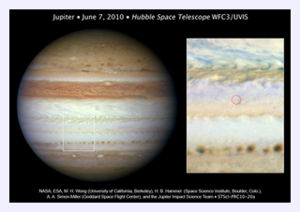
NASA, ESA, M.H. Wong (University of California, Berkeley), H.B. Hammel
(Space Science Institute, Boulder, Colo.), A.A. Simon-Miller (Goddard
Space Flight Center), and the Jupiter Impact Science Team.
Detailed
observations made by the Hubble Space Telescope have found that the
flash of light seen June 3 on Jupiter came from a giant meteor burning
up high above the planet's cloud tops. The space visitor did not plunge
deep enough into the atmosphere to explode and leave behind any
telltale cloud of debris, as seen in previous Jupiter collisions.
The
mystery fireball that smacked into Jupiter on June 3 has been
identified as a giant meteor that plunged into the planet's atmosphere
and burned up high above its cloud tops, according to new observations
from the Hubble Space Telescope.
The cosmic intruder
did not dive deep enough into Jupiter's atmosphere to explode, which
explains the lack of any telltale cloud of debris, as was seen in
previous Jupiter collisions, said Hubble astronomers, who described the
meteor's size as "giant" in a Wednesday announcement.
"We suspected for this 2010 impact there might be no big
explosion driving a giant plume, and hence no resulting debris field to
be imaged," said Heidi Hammel, a veteran Jupiter observer at the Space
Science Institute in Boulder, Colo., in a statement. "There was just
the meteor, and Hubble confirmed this."
The meteor was huge, but not as large as the object that
struck Jupiter in July 2009, or the shattered comet fragments that hit
the gas giant planet in 1994, researchers said. [Gallery: Jupiter's 2009 crash.]
The new Hubble observations also allowed scientists to get a close-up
look at changes in Jupiter's atmosphere, following the disappearance of
the dark Southern Equatorial Belt (SEB) several months ago.
In the latest Hubble view, a slightly higher altitude layer of white
ammonia ice crystal clouds appears to obscure the deeper, darker belt
clouds.
"Weather forecast for Jupiter's South Equatorial Belt: cloudy with a chance of ammonia," Hammel said.
The researchers predict that these ammonia clouds will likely clear out in a few months, as it has typically done in the past.
Jupiter gets whacked (again)
The tale of Jupiter's latest cosmic hit is one that kept scientists guessing until now.
It was Australian amateur astronomer Anthony Wesley who first
saw the flash at 4:31 p.m. (EDT) on June 3, while watching a live video
feed of Jupiter from his telescope. Meanwhile, in the Philippines,
amateur astronomer Chris Go confirmed the discovery from his own
simultaneous video recording of the transitory event.
Astronomers around the world determined that an object must
have whacked the gas giant in order to unleash a flash of energy that
was bright enough to be seen 400 million miles (643.7 million km) away.
But, with no visible scar or debris cloud from the impact, there was no telling how deep the object penetrated into the atmosphere.
The Hubble Space Telescope's sharp vision and ultraviolet sensitivity
was called into action to seek out any traces of the aftermath of the
cosmic collision.
Images taken on June 7 - a little over three days after the
flash was discovered - showed no sign of debris above Jupiter's cloud
tops. That suggests the object did not descend beneath the clouds and
explode as a fireball, astronomers said.
"If it did, dark sooty blast debris would have been ejected
and would have rained down onto the cloud tops, and the impact site
would have appeared dark in the ultraviolet and visible images due to
debris from an explosion," Hammel explained. "We see no feature that
has those distinguishing characteristics in the known vicinity of the
impact, suggesting there was no major explosion and fireball."
Jupiter impacts of times past
Dark smudges marred Jupiter's atmosphere after pieces of the comet Shoemaker-Levy 9
slammed into the planet in 1994. A similar phenomenon occurred more
recently in July 2009, when a suspected asteroid estimated to be about
1,600 feet (500 meters) wide collided with Jupiter.
This latest cosmic interloper is estimated to be only a fraction of the size of these previous impactors.
The two-second-long flash of light in the videos was created by
the same physics that causes a meteor or "shooting star" on Earth. A
shock wave is generated by ram pressure as the meteor speeds into the
planet's atmosphere, heating the impacting body to a very high
temperature.
As the hot object streaks through the atmosphere, it leaves
behind a glowing trail of superheated atmospheric gases and vaporized
meteor material that then rapidly cools and fades in the span of only a
few seconds.
Though astronomers are still uncertain about the rate of such
large meteoroid impacts on the planets in our solar system, it is
estimated that the smallest detectable events may happen as frequently
as every few weeks.
"It's difficult to even know what the current impact rates are
throughout the solar system," said Amy Simon-Miller of NASA's Goddard
Space Flight Center in Greenbelt, Md., the principal investigator on
the Jupiter observation. "That's partly why we are so excited by the
latest impact. It illustrates a new capability that can be exploited
with increased monitoring of Jupiter and the other planets."
Meteors on other planets
Even when impacts are detected, they can sometimes be misread.
"The meteor flashes are so brief they are easily missed, even in video
recordings, or perhaps misidentified as detector noise or cosmic ray
hits on imaging devices," said research team member Mike Wong of the
University of California at Berkeley.
As for Jupiter's missing cloud belt, Hubble scientists said
the space telescope's new photos showed all the warning signs of an
impending disappearance of the planet's Southern Equatorial Belt.
The clearing of the ammonia cloud layer should begin with a
number of dark spots like those seen by Hubble along the boundary of
the south tropical zone.
"The Hubble images tell us these spots are holes resulting
from localized downdrafts taking place," Simon-Miller said. "We often
see these types of holes when a change is about to occur."
"The SEB last faded in the early 1970s," Simon-Miller added.
"We haven't been able to study this at this level of detail before. The
changes of the last few years are adding to an extraordinary database
on dramatic cloud changes on Jupiter."
NASA Prepares for Potentially Damaging 2011 Meteor Shower
Leonard David
Space.com
Wed, 16 Jun 2010 14:20 EDT
NASA
is assessing the risk to spacecraft posed by the upcoming 2011 Draconid
meteor shower, a seven-hour storm of tiny space rocks that has the
potential to ding major Earth-orbiting spacecraft like the crewed
International Space Station and Hubble Space Telescope.
The meteor shower
risk assessment is actually more art than science, and there has been
some variation in the projected intensity levels of the 2011 Draconids
by meteoroid forecasters. But spacecraft operators are already being
notified to weigh defensive steps.
Current meteor forecast models project a strong Draconid
outburst, possibly a full-blown storm, on Oct. 8, 2011, according to
William Cooke of the Meteoroid Environment Office at NASA's Marshall
Space Flight Center in Huntsville, Ala.
The Draconids do present some risk to spacecraft,
Cooke confirmed. They could potentially become the next significant
event in low-Earth orbit as far as meteoroids are concerned, he added.
Cooke and Danielle Moser of Stanley, Inc., also of Huntsville,
presented their Draconid data at Meteoroids 2010 - an international
conference on minor bodies in the solar system held May 24-28 in
Breckenridge, Colo. The conference was sponsored in part by NorthWest
Research Associates/CoRADivision, NASA, Los Alamos National Laboratory
and the Office of Naval Research.
Less flashy, but risk exists
The yearly Draconids are not known for their bright meteor displays, Cooke said.
Predicted intensity rates for 2011 span an order of magnitude, he
added, with maximum Zenithal Hourly Rate, or ZHR, ranging from a few
tens to several hundred as viewed by a single observer.
A Marshall Space Flight Center Meteoroid Stream Model based on
radar and optical observations of past Draconid showers suggests that
the maximum rate will be several hundreds per hour.
So why the worry?
Cooke said that a significant fraction of spacecraft anomalies
produced by shower meteoroids are caused by electrostatic discharges
when meteoroid meets satellite.
And while no spacecraft electrical problems were reported
during the strong Draconid outbursts of 1985 and 1998, he said that the
lack of past anomalies should not be taken as carte blanche for
satellite operators to ignore in 2011.
The chance of electrical anomalies is low, however, due to the Draconids slow speed, Cooke pointed out.
"We're already working with NASA programs to deal with
spacecraft risk," Cooke said. "I imagine when the word gets out there
will be a Draconid outburst, I'll get the usual calls from comsat
companies as well as government space programs," he told SPACE.com.
Out on the limb
The International Space Station is heavily armored against orbital debris.
That being the case, "we don't expect anything to go wrong there," Cooke said.
However, the Draconids will appear above the Earth's limb
making it a spectacular looking out-the-windows celestial show for the
space station crew.
"I have no concerns about the space station. Even if the
Draconids were a full-scale meteor storm I would be confident that the
space station program would take the right steps to mitigate the risk,"
Cooke said.
The most radical step would be to reorient the space station, Cooke said.
"But frankly, given the flux levels, I don't think they are
going to have to do that," he added. "But that's their call. I'll give
then the flux levels and they'll make the decision."
One measure that space station officials could take, he added, is not to perform spacewalks during the shower.
For the Hubble Space Telescope,
if its operators deem the risk high enough, they will point the
observatory away from the Draconid radiant - the point from which the
shower appears to emanate.
"Any time you take a mitigation strategy, like changing a
spacecraft's attitude or turning off high-voltage, that incurs risk as
well," Cooke said.
Caution is key
Each spacecraft is unique, and components have differing damage
thresholds, so programs are encouraged to conduct analyses to determine
whether or not mitigation strategies are necessary for their vehicles
ahead of next year's Draconids.
Cooke said that the spacecraft threat from meteor showers in
the past - particularly the 1998 Leonids - produced more hype than
hypervelocity impacts.
"We really didn't understand what was going on," he added.
"Now we have a much better feel. But the Leonids did sensitize
spacecraft operators to worry about meteor showers. Perhaps, sometimes,
they worry more than they should."
In early 2011, Cooke said that he'll be revising his Draconid
prediction - also making use of data from other forecasters around the
globe - which will be released to spacecraft operators.
"There's also an awful lot of windage in there too," Cooke
added. "We're like the weather reporters...our forecast changes...and
the general trend is always downward," Cooke said.
Still, caution is the watchword.
"Because we can now forecast them, we have a way of putting it.
If you are hit by a sporadic [meteor], it's an act of God. If you are
hit by a shower meteoroid, it's an act of negligence," Cooke said.
Leonard David has been reporting on the space industry for more than five decades. He is past editor-in-chief of the National Space Society's Ad Astra and Space World magazines and has written for SPACE.com since 1999.

Louis
Campbell, along with his friend Violet, stand next to the scene of a
mysterious fire that took place in a field in Grahams Road Saturday
morning. After seeing a white ball of fire fall from the sky, Campbell
stomped out the flames with his boots and pitchfork.
A mysterious fire that occurred in Grahams Road Saturday morning has left residents puzzled.
Louis and Clemmie Campbell were outside in their yard when they heard a loud swishing sound.
"A white ball of fire fell from the sky," described Clemmie. "It hit the ground and smoke started coming up."
The ball of fire landed in a hay field beside the Campbell's driveway.
Clemmie phoned the New London Fire Department while her husband Louis grabbed a pitchfork and approached the flames.
By the time firefighters arrived on scene, Louis had put out the flames with his fork and boots.
"It mostly burnt out as soon as it hit the ground," said Louis.
Allan Cole of the NLFD said the fire is still a mystery.
"We found some stuff there but we don't know what it is," said Cole. "It's interesting."
Fire Marshal's Office spokesperson Connie MacNeil said the office is currently investigating the cause of the fire.
"It must be off a meteor or something," said Clemmie. "Your guess is as good as mine."
The Campbells are glad to have been home to see the incident. They say it could have been a story with a bad ending.
"The field it landed in is all dry hay," said Clemmie. "It could have spread very quickly."
The burning object disintegrated upon impact with the ground, leaving a burn spot about 10 feet by five feet.
"What it was I really don't know, but it sure made a subject for conservation," said Clemmie.
Detailed
observations made by NASA's Hubble Space Telescope have found an answer
to the flash of light seen June 3 on Jupiter. It came from a giant
meteor burning up high above Jupiter's cloud tops. The space visitor
did not plunge deep enough into the atmosphere to explode and leave
behind any telltale cloud of debris, as seen in previous Jupiter
collisions.
Astronomers around the world knew that something must have hit
the giant planet to unleash a flash of energy bright enough to be seen
400 million miles away. But they didn't know how deeply it penetrated
into the atmosphere. There have been ongoing searches for the
"black-eye" pattern of a deep direct hit.
The sharp vision and ultraviolet sensitivity of Hubble's Wide
Field Camera 3 were brought to bear on seeking out any trace evidence
of the aftermath of the cosmic collision. Images taken on June 7 - just
over three days after the flash was sighted - show no sign of debris
above Jupiter's cloud tops. This means that the object didn't descend
beneath the clouds and explode as a fireball. "If it did, dark sooty
blast debris would have been ejected and would have rained down onto
the cloud tops, and the impact site would have appeared dark in the
ultraviolet and visible images due to debris from an explosion," says
team member Heidi Hammel of the Space Science Institute in Boulder,
Colo. "We see no feature that has those distinguishing characteristics
in the known vicinity of the impact, suggesting there was no major
explosion and fireball."
Dark smudges marred Jupiter's atmosphere when a series of
comet fragments hit Jupiter in July 1994. A similar phenomenon occurred
in July 2009 when a suspected asteroid slammed into Jupiter. The latest
intruder is estimated to be only a fraction the size of these previous
impactors.
"We suspected for this 2010 impact there might be no
big explosion driving a giant plume, and hence no resulting debris
field to be imaged. There was just the meteor, and Hubble confirmed
this," adds Hammel, a veteran Jupiter observer of the 1994 string of
impacts.
Australian amateur astronomer Anthony Wesley saw the flash at
4:31 p.m. (EDT) on June 3. He was watching a live video feed of Jupiter
from his telescope. In the Philippines, amateur astronomer Chris Go
confirmed that he had simultaneously recorded the transitory event on
video.
The two-second-long flash of light in the videos of Jupiter
was created by the same physics that causes a meteor (or "shooting
star") on Earth. A shock wave generated by ram pressure as the meteor
speeds into the planet's atmosphere heats the impacting body to a very
high temperature, and as the hot object streaks through the atmosphere,
it leaves behind a glowing trail of superheated atmospheric gases and
vaporized meteor material that rapidly cools and fades in just a few
seconds.
Though astronomers are largely uncertain about the rate of
large meteoroid impacts on the planets, the best guess for Jupiter is
that the smallest detectable events may happen as frequently as every
few weeks. "The meteor flashes are so brief they are easily missed,
even in video recordings, or perhaps misidentified as detector noise or
cosmic ray hits on imaging devices," says team member Mike Wong of the
University of California at Berkeley.
"It's difficult to even know what the current impact rates are
throughout the solar system. That's partly why we are so excited by the
latest impact. It illustrates a new capability that can be exploited
with increased monitoring of Jupiter and the other planets," says Amy
Simon-Miller of NASA's Goddard Space Flight Center, the principal
investigator on the Jupiter observation.
As a bonus, the Hubble observations also allowed scientists to
get a close-up look at changes in Jupiter's atmosphere following the
disappearance of the dark Southern Equatorial Belt (SEB) several months
ago.
In the Hubble view, a slightly higher altitude layer of white
ammonia ice crystal clouds appears to obscure the deeper, darker belt
clouds. "Weather forecast for Jupiter's South Equatorial Belt: cloudy
with a chance of ammonia," Hammel says.
The team predicts that these ammonia clouds should clear out
in a few months, as it has done in the past. The clearing of the
ammonia cloud layer should begin with a number of dark spots like that
seen by Hubble along the boundary of the south tropical zone.
"The Hubble images tell us these spots are holes resulting
from localized downdrafts taking place. We often see these types of
holes when a change is about to occur," Simon-Miller says.
"The SEB last faded in the early 1970s. We haven't been able
to study this at this level of detail before," Simon-Miller adds. "The
changes of the last few years are adding to an extraordinary database
on dramatic cloud changes on Jupiter."
David Loughrey
Otago Daily Times
Thu, 17 Jun 2010 14:18 EDT
A mysterious object streaking through the sky near Kaka Point, South
Otago, yesterday evening has left local woman Andrina Kitto wondering
what it could have been.
Mrs Kitto said she was outside in the courtyard of her home at
5pm when she saw the "quite big" object, which she described as having
a white head and a "long white tail" behind it.
She watched it through binoculars for about 10 minutes as it
fell at a 45-degree trajectory to the Earth, travelling in a westward
direction from Kaka Point.
"It was travelling quite fast at the start, but got quite a bit slower as it headed to the horizon."
The tail was mainly white, but darker in patches, seemed to split into
two parallel lines further from the object itself, and that material
appeared to "waft" in the air currents, Mrs Kitto said. When she first
spotted the object, it was south of Balclutha, and appeared to be
heading towards Clinton.
Dunedin Astronomical Society president Peter Jaquiery said
while meteors could do "all sorts of things" as they fell to Earth,
they were gone in seconds.
Space junk also stayed visible for a much shorter period than 10 minutes.
Did you see this object?
LunarMeteoriteHunter
Latest Worldwide Meteor/Meteorite News
Wed, 23 Jun 2010 08:06 EDT
A ~600 gram meteorite fell about 15 meters from a ranch hand in
Varre-Sai, Rio de Janeiro State, Brazil on June 19, 2010. The images
show the meteorite and how it was found (though it was picked up first,
and then replaced for the TV camera). The person talking to the
reporter is Prof. Marcelo Souza, Professor of Physics and Astronomy at
the Universidade Estadual do Norte Fluminense, in Campos. The interview
will be aired on Brazilian TV today.
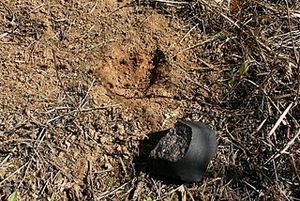
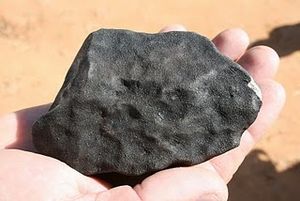
Near Hit!
There is an interesting follow-up to the daylight meteor
fireball in Brazil of June 19, 2010. At about 21.00 UT, a ranch hand
(name withheld) saw the fireball and heard explosions, after which
something fell about 15 meters away from him in a pasture. He walked
over to the spot and picked up a 600 gram meteorite that had just
fallen from the sky. He saw others fall at about the same time nearby
but hasn't been able to find them yet. He commented that the air had a
"strong smell of iron".
The meteorite appears to be an ordinary chondrite with both
primary and secondary fusion crust. I expect several more meteorites to
be found from this fall based upon eyewitness reports. The local
university and others will be joining the hunt today and in the coming
days; stay tuned-in for more.
Have information about this meteorite fall or others? Please email drtanuki@gmail.com
Previously reported:
Brazil Daytime Fireball
A daytime fireball with sonic booms was reported by many people
in Campos dos Goytacazes, Brazil on June 19 at about 21.00 UT. A local
astronomy and physics professor, Prof. Marcelo Souza, was contacted by
the fire department and others for explanation.
Map of the Campos dos Goytacazes area in Brazil
P.J. Reilly
LancasterOnline.com
Fri, 25 Jun 2010 07:26 EDT
A bright light in the sky over Lancaster County attracted the attention of at least a few people Thursday night.
What caused the light was uncertain as of press time.
Three people called the Intelligencer Journal/Lancaster New Era shortly after 10 p.m. to report seeing the light.
About the same time, several people from Pennsylvania, Maryland, New
Jersey and Connecticut posted on Twitter that they saw an object, which
they described as a "fireball" or "meteor."
"Huge, huge, huge meteor just fell over White Hall, Md.," one
person wrote. "Exploded in huge flash. Green tail. Yellow fireball
head."
Amanda Kimmich was folding laundry on the second floor of her
house on Pitney Road in Lancaster Township when she happened to look
out the window and saw a bright, white flash of light in the sky.
"It was really unique," she said. "I've seen fireworks, and this seemed bigger than that. It kind of gave me goose bumps."
The bright flash moved across the sky before it got out of Kimmich's sight, she said.
"It wasn't just a stationary flash," she said.
Several miles to the north, in Manheim Borough, John O'Donnell
was in his front yard looking north when he saw a light in the sky.
"It was a big flash of blue light, and it flashed three or
four times before this bright silver ball floated down to the ground,"
he said. "It seemed like it was right over top of us, but a little to
the north."
When the ball O'Donnell was watching dipped out of sight, he
said he "definitely heard it hit the ground. The sound was kind of
faint, but I heard a thud."
Cooper Reedy was in front of her home in Witmer facing south
when she saw a bright flash reflected in the side of her boyfriend's
car.
When she turned around, she saw a multicolored ball falling from the sky.
"We kind of thought it was a firework at first, but it never exploded, and it was way too big," she said. "It was gigantic."
A man working in the tower at Lancaster Airport said he noticed
a flash of light out of the corner of his eye to the north around 10
p.m., but he couldn't identify the source of the light.
A shift supervisor at Lancaster County-Wide Communications
said around 10:15 p.m. he had not received any calls about the light in
the sky.
LunarMeteoriteHunter
Latest Worldwide Meteor/Meteorite News
Fri, 25 Jun 2010 07:43 EDT
I recorded a very bright fireball (mag -13) over Colorado on June 23 at
UT 08:49. The radiant of this event was within my measurement error of
the radiant of the June Lyrid shower, which is suggested by the IMO as
a "possible source", and seems to have been more active in the 1960s. I
obtained an initial velocity of 47 km/s, which is high compared with
the IMO estimate of 31 km/s (I don't know how that speed was obtained).
In any case, this is an interesting fireball that fragmented explosively at a height of 53 km. I have posted a report at [Link,
see below]; be sure to check the nice videos from two of my allsky
cameras. Tom Ashcraft also caught this on his allsky camera in New
Mexico, over 400 km to the south.
Be sure to view the videos- the terminal explosion is very impressive.
Chris L Peterson
Cloudbait Observatory
http://www.cloudbait.com
June 23, 2010 Fireball
This
extremely bright fireball occurred at 02:49 AM MDT over central
Colorado. This meteor may be a member of the June Lyrid shower.
Data has been recovered from the following cameras:
A video was also recorded by a camera near Santa Fe, NM, 436 km
south of the fireball. The image at left is from the Cloudbait camera.
The peak brightness as seen from Cloudbait Observatory was apparent
magnitude -13, slightly brighter than a full Moon.
The meteor descended steeply (just 10° from vertical) over the
Buffalo Creek area of the mountains between Bailey, CO and Deckers, CO.
It first appeared at a height of 104 km, and stopped burning at a
height of 41 km. It experienced a violent fragmentation event at a
height of 53 km. The meteor had an average speed of 47 km/s (106,000
mph). NEXRAD Doppler radar (KFTG Denver) over the hour following the
fireball does not show evidence of a dust cloud.
The meteor radiant was at RA = 289°, dec = +35, in Lyra. This is very close to the June Lyrid (JLY)
meteor shower, which has a drift corrected radiant of RA = 284°, dec =
+35. That shower is not well characterized, but suggests an initial
velocity of 31 km/s, which deviates significantly from the 47 km/s
estimate for this event. This may argue against this fireball being a
June Lyrid, or it may simply demonstrate that the IMO estimated
velocity is incorrect.
The relatively high speed, steep entry angle, high altitude of
fragmentation, and probable cometary origin all make it unlikely that
any material survived to the ground. In the unlikely event that
meteorites were produced, the fall area is extremely rugged and not
practically searchable.
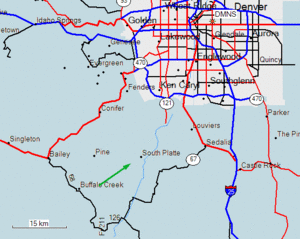
This map shows details of the fireball path. The actual flight path was 64 km long, resulting in a 11 km ground path.
Just received this note from a member of the Howard Astronomical League:
Sure, I'm interested. Did anyone at the stadium (or
Frank,
"Not sure if you have heard yet or not, but at tonight's (June 24)
Orioles game around 9:45PM there was an extremely bright meteor
(bolide) in the sky that went over the city. I was sitting on the first
base side and the meteor flew overtop the Hilton Hotel (left field of
the stadium). It was heading roughly westward and for being over the
city was very very bright! Unfortunately it was between innings and I
had put my camera down.
"I would hope though that with all the photo and TV cameras that someone must have gotten a picture or video.
"Just wanted to let you know in case you were interested. - James Willinghan"
anywhere else in the region) spot this object? If so, leave a comment
here. Better yet, if you managed to get a photo or video, let me know
and we'll post it and replace the one above.
Remember, it's very important to include detailed information
describing the object, where you were, which direction you were facing,
which direction the object was travelling, how high above the horizon
it was and how long it was visible.
Lancaster, Pennsylvania -- News 8 received calls and e-mails from
viewers after they saw a flash of light in the sky Thursday night.
Most people reported seeing a bright light in the sky at about 9:30 p.m.
News 8 checked with Cosmic Mike at North Museum in Lancaster.
He thinks the light was a fireball, which is a large meteor.
A meteor is a piece of rock or grain of sand. If the fireball is big enough, it can make a noise when it enters the atmosphere.
Cosmic Mike also said there is a meteor shower going on right
now. The peak was June 23 around the big dipper, which is where some
viewers reported seeing the fireball.
A Somerset West resident is one of several people who witnessed an object falling from the sky on Friday morning.
Caroline Brinkmann said she noticed what appeared to be a meteor while driving with her mother on the N2 near Grabouw.
She said the giant fiery ball was moving at high speed.
"We saw a very long red line just above the Hottentots Holland
Mountain. I looked like a giant ball on fire and it was leaving a trail
in the sky," she said.
The South African Astronomical Observatory said it is
investigating after receiving several similar reports from park
officials in the area.
Astronomer Enrico Oliver said it could possibly have been a meteor or a fire ball.
"At the moment we're just looking and trying to gather
information from some people who might have seen this to pinpoint what
it is," said Oliver.
Teresa Ann Boeckel
York Daily Record
Fri, 25 Jun 2010 23:51 EDT
A fireball that crossed the sky Thursday night was caught on The York Water Company's surveillance camera.
It was the same camera at the company's pumping station in Spring
Garden Township that captured a meteor in the sky last year, said
Jeffrey Hines, president and CEO of the water company.
However, the latest fireball appeared to be at a slightly different angle, he said. It showed up in the footage around 9:53 p.m.
Brian Kirby, a York City Police officer, spotted the meteor while on duty Thursday evening.
"It was pretty bright. You couldn't really miss it," he said.
"It had a pretty long tail. . . . Definitely not your average shooting
star."
The meteor traveled from east to west in the sky, Kirby said.
Meteorite hunter Mike Antonelli of the Pittsburgh area said it's
interesting the two sightings are about a year apart and might have
followed a similar trajectory.
The one that crossed the sky July 6, 2009, created a sonic
boom. Antonelli and other meteorite hunters -- including Steve Arnold
of the Science Channel show "Meteorite Men" -- visited York County to
search for clues as to where the remnants may have fallen.
It is believed the strewn field of that meteorite is in
Lancaster County. That was based on the water company's video and a
man's photograph of the fireball.
Antonelli said he still has been looking for that one.
"I've just about thrown in the towel," he said.
The latest fireball was spotted by numerous people in Lancaster County.
John O'Donnell of Manheim told the Intelligencer Journal that he was in his front yard looking north when he saw it.
"It was a big flash of blue light, and it flashed three or four
times before this bright silver ball floated down to the ground," he
said. "It seemed like it was right over top of us, but a little to the
north."
He also said he heard it hit the ground.
Meteorite hunters use video to help them figure out in which
direction the meteor was heading. Antonelli said he might head to
Manheim borough to start a search.
Martin Weil
Washington Post
Sun, 27 Jun 2010 02:25 EDT
A bright fireball flashed across the skies of the Washington region
last week, visible to people in the grandstand at a baseball game, as
well as to motorists, pedestrians and people standing on suburban
decks.
The American Meteor Society logged more than 30 reports of the
Thursday night event, from the Washington metropolitan area to
Delaware, Pennsylvania, New York and West Virginia. Almost all placed
the time at about 9:55 p.m.
"It was a very bright object," said Chris Wood, who saw it
from the deck of a house in Potomac. "It was so bright that the trees
cast shadows" in its light, he said.
"It just kept going until it was past the horizon," he added.
"It was the brightest I've ever seen at night," he said.
Wood said the meteor appeared green, but some of the other
reports on the society's Web site described it as blue or yellow. A
report from Stamford, Conn., said it had a green head and a yellow
trail.
Numerous reports were also posted on a Web site maintained by the Baltimore Sun.
One post said: "My son and I saw the meteor when we were driving in . .
. Loudoun County between . . . Leesburg and Purcellville. It was
extremely bright, had a slight green hue, and was heading in a north,
northwesterly direction. . . . It lasted for about 2-5 seconds."
Another post read: "I was walking up Connecticut Avenue in
Washington, DC and saw it as well! Biggest shooting star I've ever
seen!"
Several people wrote that they saw the fireball while in the stands at the Baltimore Orioles baseball game.
"I was in Section 14 (first base side, lower deck) at the game and saw it. It was a greenish streak."
The meteor society describes itself as a nonprofit scientific
group set up to aid amateur and professional astronomers interested in
meteors.
MysteriousOklahoma
YouTube
Tue, 22 Jun 2010 07:18 EDT
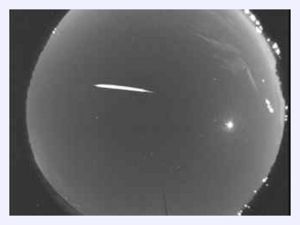
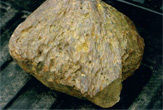

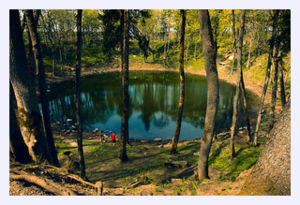



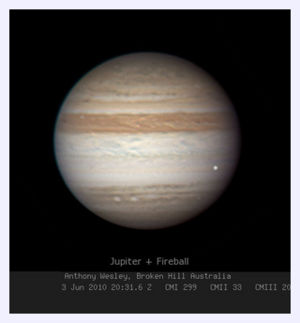
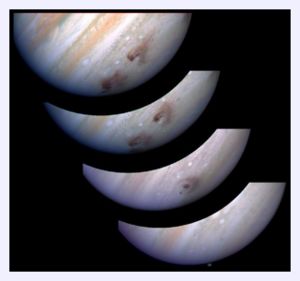
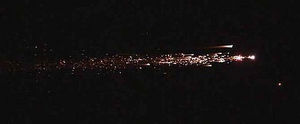
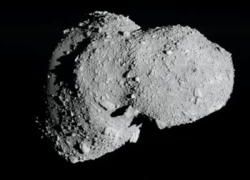
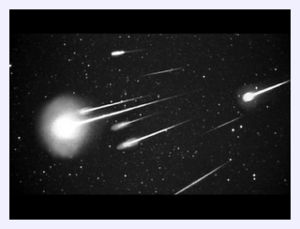

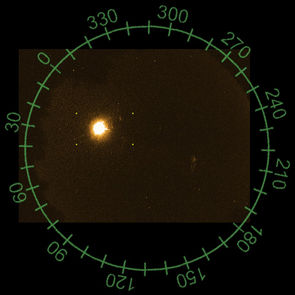
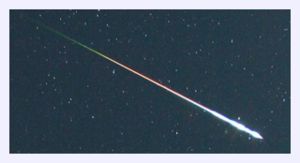
No comments:
Post a Comment